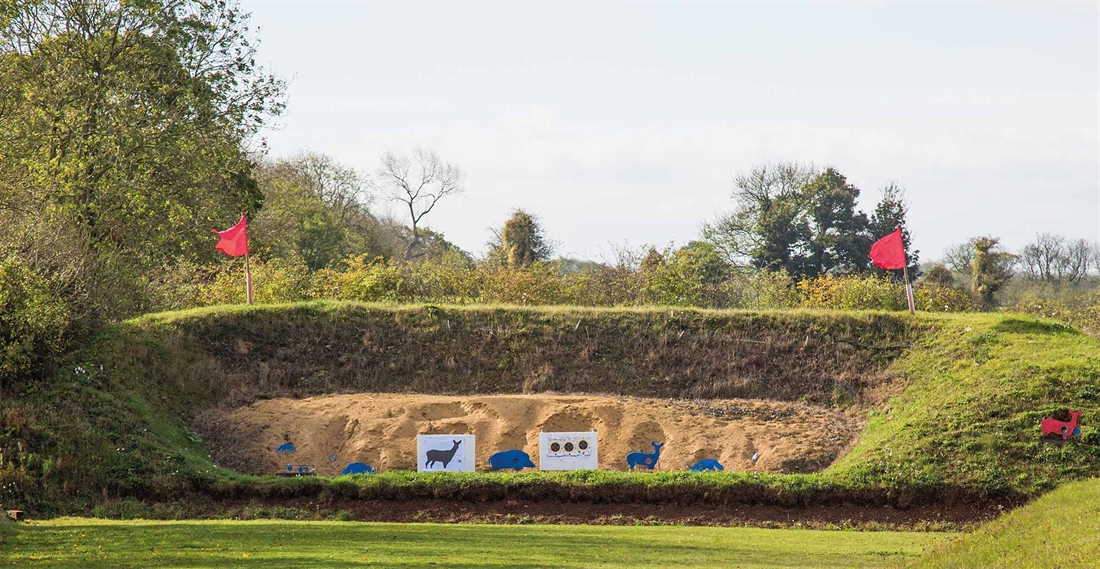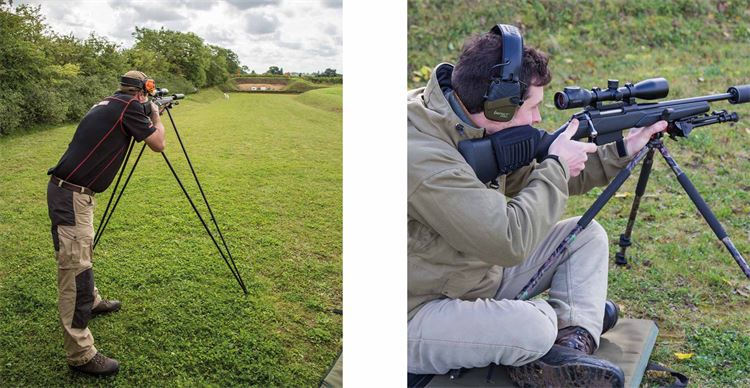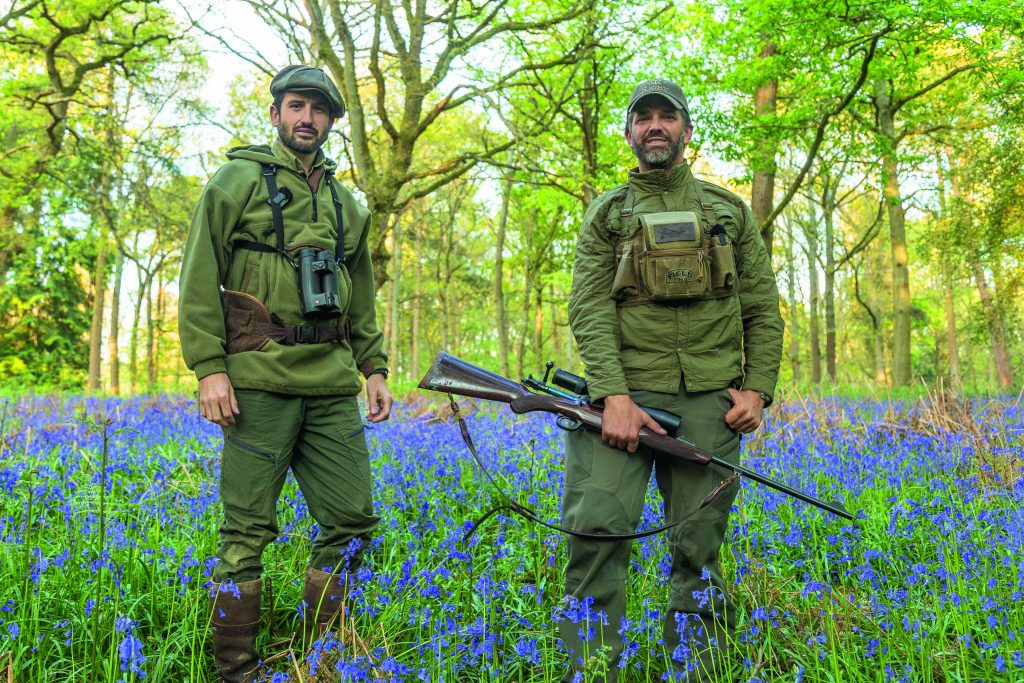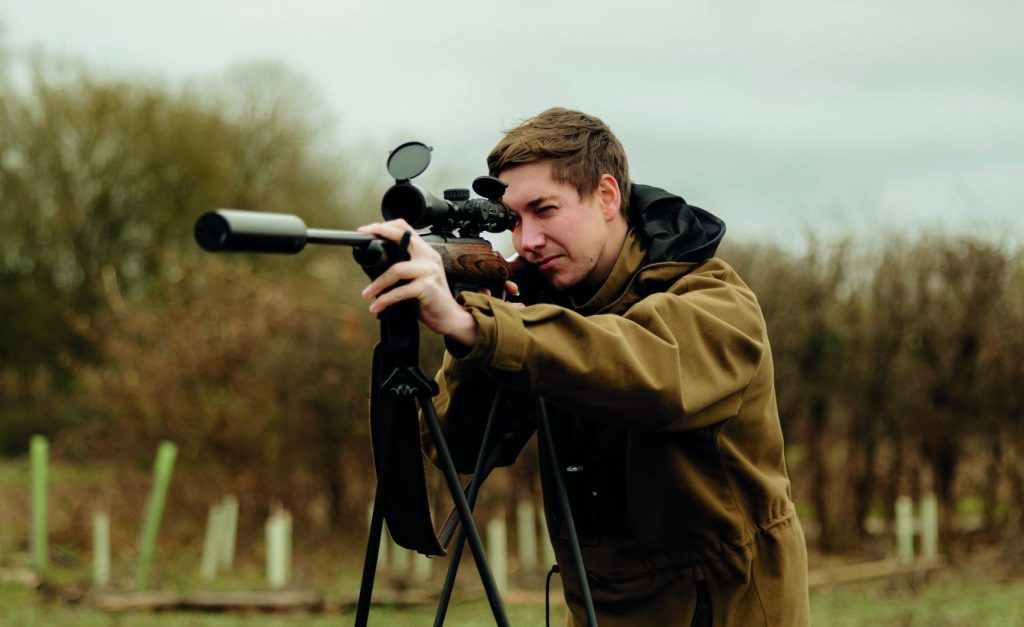Visiting the rifle range
Considering the key components of straight shooting from a range of positions applicable to real stalking situations, with the help of Corinium Rifle Range.

Firearms Certificate application, kit and courses – three areas which tend to raise questions aplenty among those new to deer stalking – were the natural place to start with this series, but how about after that, once one has a qualification or two under their belt, permission to stalk deer from a landowner, or a guided stalk in the diary?
The enthusiastic will yearn to get out there, but with how much confidence will they lean into their shooting sticks with a deer in the crosshairs if enough time is not invested in practice? Relevant practice, that is. Ethics are, of course, of primary concern – we owe it to our quarry to be proficient Shots. Yes, squeezing the trigger is a small part of the whole stalking experience, but it’s an important one.
Even experienced stalkers can learn from going back to basics and considering the constituent parts of accurate shooting from different positions which are applicable to real stalking scenarios. And this is central to the range sessions which form part of the Stalkers’ Training Programme run by Paul Hill at Corinium Rifle Range – a comprehensive course which entails safe firearms handling, carcass handling and gralloching, DSC1 and guided stalks.
Ultimately, the shot should come naturally – we shouldn’t be consciously thinking about its separate parts whilst in the field – but to get to this stage we must first put in time on the range and assess various factors.
Gunfit
The fit of a rifle is often given less thought than the fit of a shotgun. And yet this is an area not to be overlooked – comb height being of particular importance. “Most rifles are produced with combs at the right height to be shot with open sights, not mounts and then a scope,” explains Paul. “Many of those who visit the range are surprised by the difference a simple cheekpiece makes to obtaining the correct eye relief. Raising the comb height enables the shooter to achieve a proper cheek-weld and ensures that he or she is looking straight through the scope, which is crucial since reticles are two-dimensional.
“Indeed, being able to obtain correct eye relief quickly with no adjustment, in a comfortable and natural position, can make a real difference, particularly when it comes to fast target acquisition.”
Natural alignment
“Simply put, you should be shooting from a position where you are controlling the rifle, rather than the rifle controlling you,” Paul explains. “Think of the body like a spring – it will move back to the most natural position when firing a rifle. If your body is in a position that allows the rifle to point naturally at the target without any muscle tension required, you are less likely to ‘pull the shot’ (resulting in a misplaced bullet) upon squeezing the trigger.”
Trigger squeeze and control
Key to consistent shooting is correct treatment of a rifle’s trigger. Firstly, it is advisable to become accustomed to how a trigger feels and at what point it ‘breaks’ by dry firing (firing with no ammunition in the chamber). With closed eyes, one can really concentrate on the trigger squeeze. This builds familiarity that helps reduce the chances of a flinch or ‘recoil avoidance’ developing.
“The trigger should sit just behind the fleshy pad of the end joint of the index finger, but forward of its crease. Using the fleshiest part of the finger or the fingertip increases the odds of pulling the trigger to the side rather than straight back – a big no, no,” asserts Paul. “The focus should be on gradually squeezing the trigger straight back so the rifle is not moved in any way by the action. And the shot should almost come as a surprise.”
Follow through
The process followed after the shot is also of great importance. Keeping the cheek in firm contact with the stock upon and after firing, continuing to look through the scope when and after the shot has been taken, and releasing the trigger only when the recoil has stopped, allows the rifle to fire naturally and the stalker to assess the reaction of his/her quarry – and take a follow up shot quickly if required. “It is essential that the stalker can watch the quarry as he/she reloads immediately following the shot,” asserts Paul. “Many novices forget to do this as they are so consumed by the shot, so it is something we focus on here at Corinium.”
Smooth, natural shooting
Paul is a big advocate of smooth, natural shooting where the shooter has to trust himself/herself and avoid overthinking things. “A common bad habit is to begin checking oneself,” he explains. “There are several constituent parts to a successful shot, but the process should be as one. The same principle applies to many other sports – catching a ball or swinging a golf club, for example.
“Our eyes and our body are amazing things and we have to learn to trust them. A big mistake is focusing on the reticle rather than the target, prolonging the shot and sending the crosshairs unsteady.” Ever carried a cup of tea and tried to steady your hand whilst watching the tea slosh from side to side? You invariably cause the hand to be even more unsteady. The same applies here.
The second golden rule of good shooting is to ‘aim small’. Focus hard on a small part of the target or quarry and the chances are, if your shot placement is off, it will only be so by a small fraction. Sure enough, during my range sessions with Paul, I shot more accurately when focusing on 2″ disc targets than I did when focusing on a 4″ heart-shaped silhouette as part of a larger target. “When throwing a cricket ball to the wicket-keeper during a game of cricket, you’d aim for their gloves, not just their body in general,” expands Paul. “Aim small, miss small.”
Shooting positions
Making practice relevant to your type of stalking is key. During my range sessions, three basic positions were practised.
Prone: A position most commonly used on the open hill, the prone position is widely regarded as being the most stable of the shooting positions and is typically preferred for shots taken at greater range.
“There has been a trend to spread the elbows wide to get low to the ground when shooting from the prone position,” explains Paul, “but this is unnecessary in stalking and has its roots in the military where staying low reduces the target area when being shot at.
“Shooting from a very low position can mean the chest is cramped when breathing, and it can also affect how you look through the scope.” Instead of focusing on being low to the ground, Paul had me focus on natural alignment and comfort – my left forearm coming across my chest and acting as a prop for the stock of the rifle.
We also touched on breathing – a factor Paul doesn’t like trainees to get too worked up about as it can distract them from focusing on the target. Aligning the crosshairs on the target before breathing in slowly, then exhaling (but not completely), and squeezing the trigger when the body is relaxed and the rifle is at its steadiest – always focusing on the target rather than the reticle – was the drill.
Standing: The majority of shots taken when woodland stalking are from a standing position, off sticks, and yet Paul believes that few stalkers regularly practise shooting from such a position, instead preferring to sit at a bench or lie prone.
In recent years, a great many sticks have been introduced to the market place – a number of which enable the stalker to shoot with a greater degree of accuracy and consistency from a standing position. Designs which are light but stable, easy to manoeuvre and quiet are key, which explains the rise in popularity of quadsticks which provide a rest for both the fore-end and stock of the rifle.
“At Corinium, we teach candidates to stand with straight legs, shoulders 45 degrees to the target, and a wide stance, and then lean into the sticks,” explains Paul. “Not only is this steadier than shooting from a very upright position, but it is much better suited to real stalking situations; rarely will you find yourself on perfectly level terrain when in pursuit of deer. This position also allows one to manoeuvre the sticks easily by simply moving towards them or away from them, or moving the stick arms with one’s hands. Some deer species, particularly fallow and muntjac, are by nature very mobile and typically move a lot before presenting a shot, so this is key.”
Sitting or kneeling: The sitting or kneeling position can be difficult to master, but is useful when shooting on a steep slope. The steadiest sitting position is with crossed legs, and for this it helps if you are limber. The body should be 45 degrees to the target, with ankles flat to the ground. One can rest their elbows over the knees but more common now is to use sticks on which to rest the fore-end of the rifle.
Addressing natural movement
“Learning to use any vertical movement as a result of breathing when shooting from less stable positions is an important skill for the stalker,” acknowledges Paul. “The method we teach here is designed to minimise the chances of wounding an animal. With the paper target in their field of view, candidates learn to work their way upwards from the back crease of the deer’s front leg, and squeeze the trigger after a very brief pause, whilst remaining relaxed and focused on a small part of the the heart/lung area of the target. This gradual upward motion before the pause tends to result in very few low shots.
“High shots are generally not a problem. If higher than the heart, the bullet hits the lungs, which is still lethal. Higher still and it is a spine shot, which will incapacitate the animal. Any higher than that, and it’s a clean miss. A low shot, however, could break legs or penetrate the brisket, whilst a shot too far back is never good news.”
Related Articles
Get the latest news delivered direct to your door
Subscribe to Fieldsports Journal
Elevate your experience in the field with a subscription to Fieldsports Journal, the premium publication for passionate country sports enthusiasts. This bi-monthly journal delivers unparalleled coverage of game shooting, fishing and big game across the UK and beyond.
Each issue offers a stunning collection of in-depth features, expert opinions and world-class photography, all presented in a timeless yet contemporary design.
Save 10% on shop price when you subscribe, with a choice of packages that work for you. Choose from Print & Digital or Digital only with each journal delivered directly to your door or via the app every other month, plus access to past issues with the digital back issue library.










